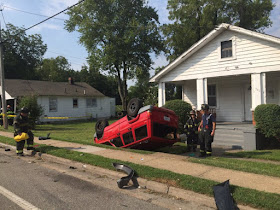THE DEADLY U.S. ROADS: U.S. Traffic Deaths Jump by 10.4 Percent in First Half of 2016; 17,775 people died on the road, hundreds of thousands injured
U.S. Traffic Deaths Jump by 10.4 Percent in First Half of 2016
by The Associated Press
U.S. traffic fatalities rose by an estimated 10.4 percent in the first half of this year, federal officials said Wednesday, and continued an upward trend that started in late 2014 as the economic recovery accelerated.
The Transportation Department released the preliminary estimate at a conference where government agencies, the National Safety Council and other safety groups announced an ambitious goal of eliminating traffic deaths and injuries in the United States within the next 30 years.
"We have an immediate crisis on our hands, and we also have a long-term challenge," said Mark Rosekind, head of the National Highway Traffic Safety Administration.
Male motorists are twice as likely to be killed behind the wheel as women. Also blacks and Hispanics cause disproportionately higher traffic deaths and injuries, according to National Highway Traffic Safety Administration data. Ringo H.W. Chiu / AP
The sharp increase in deaths this year follows a 7.2 percent jump in 2015, when there were 35,092 traffic fatalities.
For the first half of 2016, 17,775 people died on the road, compared with 16,100 over the same period a year earlier.
The improving economy means people are doing more driving on U.S. roads than ever before. U.S. drivers put in a record 1.58 trillion miles on the road in the first half of this year, 3.3 percent more than during the same period in 2015, the Federal Highway Administration said this week. So, a 3 percent rise in the miles traveled resulted in 10.4 increase in traffic deaths.
The Transportation Department said it is committing $1 million a year for the next three years for grants for the zero deaths campaign. The rapid introduction of self-driving cars and other advanced technologies may make it possible to achieve the elimination of traffic deaths, the department said in a statement. Fully autonomous vehicles hold the potential to eliminate human error, which is a factor in 94 percent of crashes, according to the department.
The zero deaths idea was first adopted in Sweden in 1997 as a plan called Vision Zero. It has since been adopted elsewhere, including several U.S. cities.
UNITED STATES STILL HAS ONE OF THE HIGHEST ROAD ACCIDENT DEATH AND INJURY RATES IN THE WORLD: 34,000 DIE AND 2.5 MILLION INJURED EACH YEAR.
Despite the improvements in road safety, the United States has one of the highest death rates at about 1 person dead per 10,000 people. Unfortunately, only undeveloped countries have higher death rate.
Some states, such as Texas and West Virginia (sorry, WV, despite your tremendous progress in traffic safety, you are still at the top of the worst-death-rate list) have death rates of nearly 1.5 percent, i.e., fifty percent more people die compared to the national death rate.
Approximately 34,000 people are getting killed each year. In the 1950s and 1960s, about 55,000 people used to die on the roads – so, there has been improvement in the number of dead.
However, the number of injured is rising. Roughly 2.5 million are injured (yes, you read it correctly – 2.5 million injured) per year. That is, 1 percent (1%) of the population that is eligible to drive is injured every year.
It is worse than a war zone out there. So, please be safe and be on the lookout for weaving-through-the-traffic drivers, crazy drivers, reckless drivers, sick drivers, medical-condition drivers, sleepy drivers, negligent drivers, stupid drivers, careless drivers, drunk drivers, speeding drivers, drugged drivers, texting drivers, talking-on-the-phone drivers, looking-at-the-GPS drivers, hurry-hurry drivers, tailgating drivers, upset drivers, eating-while-driving drivers, putting-the-lipstick-on-while-driving drivers, elderly drivers, and so on.



